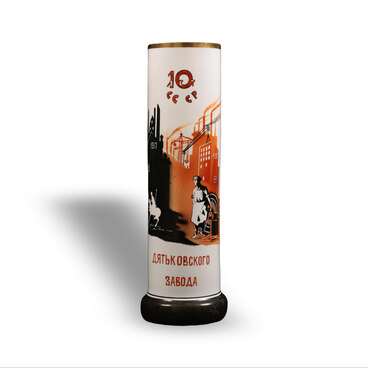The pitcher on display was produced by the craftsmen of the Dyatkovo Crystal Factory in the 19th century. The pitcher was made of red-purple glass that is known as the “gold ruby”. In the 19th century, many glass factories stopped producing colored glass because it was not as trendy as shining crystal, while the Dyatkovo Crystal Factory continued making colorful glass and crystal in a wide range of shades. As a result, when the colored glass trend made a comeback, other factories had to master the forgotten technologies from scratch, while the Maltsov factories, having continued producing colored glass throughout the century, got an advantage over them. Their facilities had developed and mastered a wide color palette.
The “gold ruby” is one of the most beautiful and expensive types of art glass. The color is obtained by using gold compounds. Red glass of various shades, from scarlet to purple is known as “ruby glass” or simply “rubies”. The “gold ruby” is the red-purple glass that contains fine particles of metal gold that can only be seen in finished products under a microscope with high magnification. Depending on the heating conditions, glass painted with gold can take on such shades as pink, purple, and sometimes even blue. The Dyatkovo Crystal Factory mastered the process of making the “gold ruby” glass in the first half of the 19th century and produced such items for over a century.
The “gold ruby” technique was first discovered by the German chemist Johann Kunckel in the 17th century. The scientist took the secret of the invention to his grave, even asking future generations to forgive him for doing so in a letter he wrote before his death. The “gold ruby” was once again invented by the great Russian scientist Mikhail Lomonosov who can rightly be called the father of Russian glass science. This pitcher was made using the free blowing technique where the finished product is created immediately at the glass melting furnace. The Russian term for this technique “gutnaya” originated from the Latin word “gutta” meaning “a drop”. The technique was rather complicated due to the high temperatures and the quick hardening of the hot glass mass. Despite the complicated manufacturing process, the pitcher was mass produced. According to the 19th-century price list of the Dyatkovo Crystal Factory, it was known as “a pitcher with buttons” because of the pattern of drop-shaped bumps. It was donated to the museum by a woman from Dyatkovo.
The “gold ruby” is one of the most beautiful and expensive types of art glass. The color is obtained by using gold compounds. Red glass of various shades, from scarlet to purple is known as “ruby glass” or simply “rubies”. The “gold ruby” is the red-purple glass that contains fine particles of metal gold that can only be seen in finished products under a microscope with high magnification. Depending on the heating conditions, glass painted with gold can take on such shades as pink, purple, and sometimes even blue. The Dyatkovo Crystal Factory mastered the process of making the “gold ruby” glass in the first half of the 19th century and produced such items for over a century.
The “gold ruby” technique was first discovered by the German chemist Johann Kunckel in the 17th century. The scientist took the secret of the invention to his grave, even asking future generations to forgive him for doing so in a letter he wrote before his death. The “gold ruby” was once again invented by the great Russian scientist Mikhail Lomonosov who can rightly be called the father of Russian glass science. This pitcher was made using the free blowing technique where the finished product is created immediately at the glass melting furnace. The Russian term for this technique “gutnaya” originated from the Latin word “gutta” meaning “a drop”. The technique was rather complicated due to the high temperatures and the quick hardening of the hot glass mass. Despite the complicated manufacturing process, the pitcher was mass produced. According to the 19th-century price list of the Dyatkovo Crystal Factory, it was known as “a pitcher with buttons” because of the pattern of drop-shaped bumps. It was donated to the museum by a woman from Dyatkovo.


